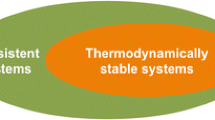Abstract
The levels that compose biological hierarchies each have their own energetic, spatial and temporal structure. Indeed, it is the discontinuity in energy relationships between levels, as well as the similarity of sub-systems that support them, that permits levels to be defined. In this paper, the temporal structure of living hierarchies, in particular that pertaining to Human society, is examined. Consideration is given to the period defining the lifespan of entities at each level and to a periodic event considered fundamental to the maintenance of that level. The ratio between the duration of these two periods is found to be approximately 2.5 × 104. A similar relationship is found when lower, non-living levels of molecules and atoms are considered. This suggests that there is a constant factor of amplification between analogous periodic events at successive levels of the Human hierarchy.
Similar content being viewed by others
References
Barlow, P.W. (1987). The hierarchical organization of plants and the transfer of information during their development. Postepy Biologii Komórki 14: 63–82.
Bennett, J.G. (1966). The Dramatic Universe, Vols 3 and 4. London, Hodder and Stoughton.
Bennett, M.D. (1987). Variation in genomic form in plants and its ecological implications. New Phytol. 106 (Suppl.): 177–200.
Bullough, W.S. (1965). The diurnal cycle in epidermal mitotic duration and its relation to chalone and adrenalin. Exp. Cell Res. 43: 343–350.
Dirac, P.A.M. (1938). A new basis for cosmology. Proc. Roy. Soc., London, Ser. A 165: 199–208.
Edmunds, L.N. and Adams, K.J. (1981). Clocked cell cycle clocks. Science 211, 1002–1013.
Ehret, C.F. and Trucco, T. (1967). Molecular models for the circadian clock. I. The chronon concept. J. Theoret. Biol. 15: 240–262.
Eigen, M. and Hammes, G.G. (1963). Elementary steps in enzyme reactions. Adv. Enzymol. 25: 1–38.
Geiger, G (1990). Evolutionary Instability. Logical and Material Aspects of a Unified Theory of Biosocial Evolution. Berlin, Springer-Verlag.
Goldberg, A.L. and St John, A. (1976). Intracellular protein degradation in mammalian and bacterial cells. Part II. Ann. Rev. Biochem. 45: 747–803.
Govinda, A. (1960). Foundations of Tibetan Mysticism. London, Rider and Co.
Grene, M. (1987). Hierarchies in biology. Amer. Sci. 75: 504–510.
Halberg, F. and Reinberg, A. (1967). Rythmes circadiens et rythmes de basses fréquences en physiologie humaine. J. Physiol. (Paris) 59: 117–200.
Harel, D., Unger, R. and Sussman J.L. (1986). Beauty is in the genes of the beholder. Trends Biochem. Sci. 11: 155–156.
Hess, B. (1968). Biochemical regulations. In: M. Mesarovic, ed., Systems Theory in Biology, p. 88–114. Berlin, Springer-Verlag.
Hess, B. and Boiteux, A. (1970). Oscillatory phenomena in biochemistry. Ann. Rev. Biochem. 40: 237–258.
Hess, B., Brand, K. and Pye, K. (1966). Continuous oscillations in a cell-free extract of S. carlsbergensis. Biochem. Biophys. Res. Commun. 23: 102–108.
Miller, J.G. (1978). Living Systems. New York, McGraw-Hill.
Miller, J.L. (1990). The timer. A newly recognized subsystem at eight levels of living systems. Behav. Sci. 35: 164–196.
Ouspensky, P.D. (1950). In Search of the Miraculous. London, Routledge and Kegan Paul.
Palmer, T. (1985). Understanding Enzymes. 2nd Ed. Chichester, Ellis Horwood Ltd.
Paris-Teynac, E. (1963). Contribution a la connaissance des fleuves d'Afrique tropical et en particulier le Nil. Les crues exceptionelles. Bull. Inst. Franc. d'Afrique Noir 25, Ser. A: 1–23.
Potten, C.S. (1987). Possible defects in the proliferative organization and control mechanisms in psoriasis. In: E.M. Farber, L. Nall, V. Morhenn and P.H. Jacobs, eds, Psoriasis. Proceedings of the Fourth International Symposium, p.15–35. New York, Elsevier.
Potten, C.S., Kellet, M., Roberts, S.A., Rew, D.A. and Wilson, G.D. (1992). The measurement of in vivo proliferation in human colorectal mucosa using bromodeoxyuridine. Gut, 33: 71–75.
Schleidt M. and Feldhutter, I. (1989). Universal time constant in human short-term behavior. Naturwiss 76: 127–128.
Simon, H.A. (1962). The architecture of complexity. Proc. Amer. Philos. Soc. 106: 467–482.
Raju, U., Koumenis, C., Nunez-Regueiro, M. and Eskin, A. (1991). Alteration of the phase and period of a circadian oscillator by a reversible transcription inhibitor. Science 253: 673–675.
Tomaschek, R. (1959, 1960). Great earthquakes and the astronomical position of Uranus. Nature 184: 177–178; - ibid, 186: 337–338.
Toynbee, A. (1972). A Study of History. Oxford, Oxford University Press.
Yukteshwar, Swami Sri (1949). The Holy Science. Los Angeles, Self-Realization Fellowship.
Author information
Authors and Affiliations
Rights and permissions
About this article
Cite this article
Barlow, P.W. A Constant of temporal structure in the human hierarchy and other systems. Acta Biotheor 40, 321–328 (1992). https://doi.org/10.1007/BF00046331
Received:
Issue Date:
DOI: https://doi.org/10.1007/BF00046331




